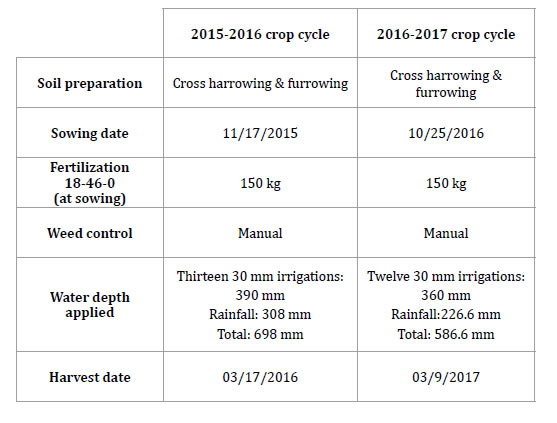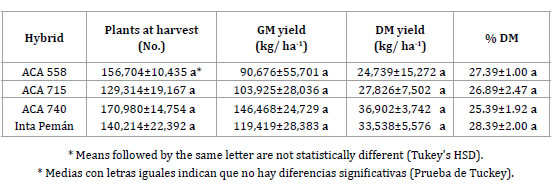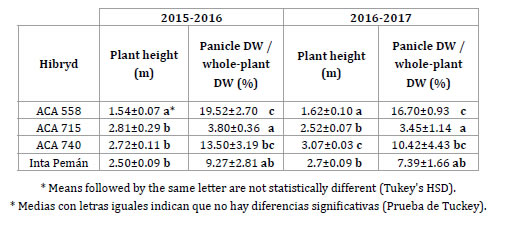
NOTA CIENTIFICA
Sorghum silage production in the northern oasis of Mendoza, Argentina
Producción de sorgos sileros en el oasis norte de Mendoza, Argentina
Leandra Ibarguren1, Cecilia Rebora1, Alejandra Bertona1, Carlos Antonini1
1Universidad Nacional de Cuyo. Facultad de Ciencias Agrarias. Departamento de Producción Agropecuaria. Cátedra de Agricultura Especial. Almirante Brown 500. Chacras de Coria - Luján de Cuyo. CPA M5528AHB. Mendoza. Argentina. libarguren@fca.uncu.edu.ar
Originales: Recepción: 06/06/2018 - Aceptación: 06/07/2019
ABSTRACT
The study and use of preserved forages in the northern oasis of the province of Mendoza arise from the expansion of intensive farming in the area combined with the limited supply of forage due to the seasonal nature of perennial pasture production. Forage-type sorghums are a silage option because they adapt well to limiting edaphoclimatic conditions and have high forage yields. This paper evaluates four sorghum hybrids for whole-plant silage (ACA 558, ACA 715, ACA 740, Silero Inta-Pemán) cultivated in Mendoza's northern oasis (33°00'38" S and 68°52'28" O) during the 2015-2016 and 2016-2017 crop cycles. Genotypes were characterized according to green matter (GM) and dry matter (DM) yields, plant height, and to the panicle dry weight/whole-plant dry weight ratio. No significant differences (p≥0.05) were observed in GM or DM yields among the hybrids in the crop cycles under study. In the 2015-2016 crop cycle, the average GM and DM yields were 110,024 kg/ha-1 and 30,914 kg/ha-1, respectively, whereas during the 2016-2017 crop cycle, the average GM and DM yields were 115,122 kg/ha-1 and 30.752 kg/ha-1, respectively. The results obtained confirm that whole-plant sorghum silage is an interesting forage resource for intensive cattle farming in Mendoza.
Keywords: Forage; Intensive cattle farming; Arid areas
RESUMEN El crecimiento de la ganadería intensiva en Mendoza y la falta de alimento debido a la estacionalidad de las pasturas durante el año, motivó el uso y estudio de forrajes conservados en la Provincia. Los sorgos forrajeros son una alternativa para ensilar, debido a su reconocida adaptación a condiciones edafoclimáticas limitantes y su elevada producción de forraje. En este trabajo se evaluaron cuatro híbridos de sorgo para silaje (ACA 558, ACA 715, ACA 740, Silero Inta-Pemán) cultivados en el oasis norte de Mendoza (33°00'38" S y 68°52'28" O), durante las campañas 2015-2016 y 2016-2017. Se caracterizaron los genotipos evaluados de acuerdo con: producción de materia verde (MV) y de materia seca (MS), altura de plantas y relación peso seco panoja/peso seco planta entera. No se observaron diferencias significativas en el rendimiento de MV ni en MS entre los híbridos en las campañas evaluadas. En la campaña 2015-2016 la MV promedio fue de 110.024 kg/ha y la MS de 30.914 kg/ha. En la siguiente campaña (2016-2017) se obtuvieron 115.122 kg/ha de MV promedio y 30.752 kg/ha de MS. Los resultados obtenidos confirman que el silaje de sorgo es un recurso forrajero interesante para intensificar la ganadería en la Provincia.
Palabras clave: Forraje; Producción ganadera intensiva; Zonas áridas
INTRODUCTION
Known for a long time, silage preserves high moisture forage by storing it for fermentation, which takes place through the activity of anaerobic bacteria on the sugar content of cells. The process makes it possible to maintain a reduced pH under anaerobic conditions throughout forage preservation (5).
In Argentina, corn (Zea maiz) is the quintessential silage cereal; however, sorghum (Sorghum bicolor L.), because of its low water requirement, tolerance to high temperatures and highly efficient use of fertilizers, has recently become popular (6). Several characteristics of sorghum, although without the prestige of other cereal grains, make it a necessary option in areas with edaphoclimatic constraints. Sorghum does well in a broad ecological area extending approximately from 22° S to 40° S and delimited in the west by the 500 mm isohyet of annual precipitation. The southern boundary is determined by a period of 180 frost free days and by the 14°C mean annual isotherm (3).
According to Torrecillas (2006), the main advantages of silage sorghum production are the following: 1- Compared to corn, sorghum has a lower water requirement, higher nutrient uptake efficiency, and greater tolerance to drought and degraded soils. 2- Some sorghum genotypes are able to remain in a state of latency for prolonged periods of drought and then resume growth (although they do not reach full yield potential). 3- The vegetative component of many sorghum genotypes is of high nutritional quality. 4- Sorghum adapts well to low-fertility, saline and floodable soils.
Sorghum has a low planting cost
For whole plant sorghum silage to be of high nutritional quality special attention should be paid to some of the plant traits, such as digestibility. Parts of the plant, such as the lignin in the cane, are scarcely digestible, reducing its nutritional value; therefore, lowering the cane ratio increases digestibility (6). BMR (Brown Mid Rib) sorghums are characterized by little lignin and high digestibility. The panicle/whole-plant ratio should also be high, as it is indicative of a high proportion of grains and, consequently, of the higher energy content of whole- plant silage. Another characteristic to be taken into consideration is the dry matter content of sorghum for silage, which should be at least 30%. Otherwise, nutrients are lost by leaching while clostridium growth and butyric acid production are promoted, increasing losses and reducing silage quality. Good whole-plant silage is important to enhance use efficiency of forage resources and profitability in cattle-raising systems. Successful silage begins with grain cultivation, continues with silo construction, preservation and supply, and ends with animal yield (meat or milk) (2).
The expansion of agriculture in Argentina, which has displaced cattle raising to extra-Pampean regions, has given the province of Mendoza the opportunity to engage in intensive cattle farming. Suitable agro-climatic conditions for the cultivation of forage crops, the availability of almost 100,000 hectares with irrigation rights among other strengths contribute to the potential for cattle farming in Mendoza’s irrigated oases (9).
One of the main problems cattle farms are confronted with is the lack of feed due to the seasonal nature of pasture. For that reason, preserved forages are used as they ensure the supply of high quality and yield forage that meets beef cattle requirements (1). Forage sorghum, given its wel-lknown adaptability to limiting soil and its climate conditions and high forage yield (10), is a good silage option for Mendoza. Moreover, in adverse conditions, sorghum usually does better than corn as forage (7, 8, 10).
Through various trials conducted within the framework of this study, regional information was obtained on the production of silage sorghum under the growing conditions prevailing in Mendoza's northern oasis. Specific objectives were to compare green matter (GM) and dry matter (DM) yields per hectare of four sorghum genotypes; and to characterize the genotypes assessed according to plant height and the panicle dry weight (DW)/whole-plant dry weight ratio.
The hypothesis is that dry matter yields per hectare vary among the different sorghum hybrids.
MATERIALS AND METHODS
During the 2015-2016 and 2016-2017 crop cycles four sorghum hybrids - ACA 558, ACA 715, ACA 740, and Silero INTA-Pemán- were grown at the San Antonio agricultural experiment station of the Facultad de Ciencias Agrarias de la Universidad Nacional de Cuyo, Mendoza (33°00'38" S and 68°52'28" W). Its alluvial soil has a clay-loam texture, the mean annual temperature is 15.7°C and the mean annual rainfall is 248.4 mm (Estación Meteorológica Chacras de Coria, 1959-2013). The experimental plots had three 10 m-long furrows 0.60 m apart; and 15 seeds per linear meter were hand sown (234,400 plants/ha). The experimental design consisted of randomly selected plots with three replications (4 hybrids times 3 replications = 12 experimental plots).
The plants were harvested when the grain was at the milk-wax stage of ripeness. At pre-harvest the number of plants was counted, and the height of 10 plants in the central row of each experimental plot was measured.
The central row of each plot was harvested (with scissors) to estimate GM yield. Three plants from each plot were weighed while green and separated to calculate the percentage of dry matter, panicle dry weight, and whole-plant dry weight.
Analysis of variance and comparison of means (Tukey test) were performed on the variables under study. Plot management is described in table 1.
Table 1. Cultural management of the experimental plots- 2015-2016 and 2016-2017 crop cycles.
Tabla 1. Manejo cultural de las parcelas experimentales, campañas 2015-2016 y 2016-2017.

RESULTS AND DISCUSSION
The GM and DM yields of the hybrids evaluated in both crop cycles are shown in tables 2 and 3 (page 125).
Table 2. Green matter (GM) and dry matter (DM) yields, and percentage of dry matter (% DM) of the sorghum hybrids included in the trial. 2015-2016 crop cycle, Luján de Cuyo, Mendoza, Argentina.
Tabla 2. Producción de materia verde (MV), materia seca (MS) y porcentaje de materia seca (% MS) de los distintos híbridos de sorgo ensayados. Campaña 2015-2016, Luján de Cuyo, Mendoza, Argentina.

Table 3. Green matter (GM) and dry matter (DM) yields, and percentage of dry matter (% DM) of the sorghum hybrids included in the trial. 2016-2017 crop cycle, Luján de Cuyo, Mendoza, Argentina.
Tabla 3. Producción de materia verde (MV), materia seca (MS) y porcentaje de materia seca (%MS) de los distintos híbridos de sorgo ensayados. Campaña 2016-2017, Luján de Cuyo, Mendoza, Argentina.

No significant differences (p≤0.05) in yields among genotypes were detected in both crop cycles. In the 2015-2016 crop cycle average GM and DM yields were 110,024 kg/ha-1 and 30,914 kg/ha-1, respectively, whereas during the 2016-2017 crop cycle average GM and DM yields were 115,122 kg/ha-1 and 30,752 kg/ha-1, respectively.
Experiences in other parts of the country, though under rainfed conditions, show lower yields per hectare: 10,789 kg of DM/ha-1 and 43,754 kg of GM/ha-1 on average for 19 sorghum hybrids tested at the AER INTA Manfredi, province of Córdoba (3); and 12,250 kg of DM/ha-1 on average in tests carried out at EEA INTA Corrientes (4). With regards to dry matter percentage of the whole plant at harvest, no differences among hybrids were detected in none crop cycle: the average value was 28.32% for the first harvest and 27.01% the following year. Leiva et al. (2012) obtained a DM average of 25.61%.
With regard to plant height, there were significant differences (p≤0.05) among hybrids in both crop cycles, as shown in table 4.
Table 4. Plant height, and panicle DW/ whole-plant DW ratio of the sorghum hybrids included in the trial. 2015-2016 and 2016-2017 crop cycles, Luján de Cuyo, Mendoza, Argentina.
Tabla 4. Altura de planta y relación PS panoja/PS planta entera de los distintos híbridos de sorgo ensayados. Ambas campañas, Luján de Cuyo, Mendoza, Argentina.

In the first harvest ACA 715, ACA 740 and Inta Pemán showed significant differences only with ACA 558. In the second harvest, ACA 715 and Inta Pemán exhibited no differences between them but with ACA 558 and ACA 740, which also differed among themselves.
The panicle dry weight/wholeplant dry weight ratio showed the same difference among hybrids in both crop cycles.
CONCLUSIONS
It is feasible to achieve high yields from silage sorghum in Mendoza's northern oasis. Although the hybrids tested exhibited significant differences in plant height and in the panicle dry weight/ whole-plant dry weight ratio, their performance with regard to green matter yield (kg/ha-1) and dry matter yield (kg/ ha-1) showed no differences. Therefore, our working hypothesis is rejected.
The results obtained confirm that sorghum silage is an interesting and feasible forage resource for intensive cattle farming in the province of Mendoza. In future trials it would be desirable to determine forage quality by analyzing crude protein (CP) and acid detergent fiber (ADF) and, from the results then obtained, to calculate digestibility (Dig) and energy concentration (EC) of the chopped forage.
1. Carrillo, J. 2003. Manejo de Pasturas. EEA INTA Balcarce. 457 p.
2. Flores, J. 2015. Claves de un buen silo de sorgo. Avaliable in: http://marcaliquida.com.ar/clavesde- un-buen-silo-de-sorgo/ (Accessed May 2016).
3. Giorda, L. 2017. Variedades de sorgo para cada utilización y su manejo. Avaliable in: https:// inta.gob.ar/sites/default/files/inta_manfredi_y_el_sorgo_variedades_de_sorgo_para_ cada_utilizacion_y_su_manejo.pdf (Accessed May 2019).
4. Leiva, M.; Clausen, A.; Clausen, S. 2012. Evaluación de sorgos sileros en el noroeste de Córdoba. INTA, Cartilla digital Manfredi. Avaliable in: http://inta.gob.ar/sites/default/files/ script-tmp-evaluacion_sorgos_sileros.pdf (Accessed May 2018).
5. Peiretti, J. 2019. Silajes: claves para incrementar la calidad en la presente campaña. Avaliable in: https://inta.gob.ar/sites/default/files/silaje_claves_para_incrementar_calidad.pdf (Accessed April 2019).
6. Pereyra, M.; Roig, H.; Acosta, F. 2011. Silo de sorgo: análisis económico de una estrategia de alimentación. Sitio argentino de producción animal. Avaliable in: http://www. produccion-animal.com.ar/produccion_y_manejo_reservas/reservas_silos/173-Silo_ sorgo.pdf (Accessed May 2018).
7. Rebora, C.; Ibarguren, L. 2018. Producción de maíces y sorgos sileros en Mendoza. Suplemento Fincas Diario Los Andes. Avaliable in: https://losandes.com.ar/article/produccion-demaices- y-sorgos-sileros-en-mendoza (Accessed May 2018).
8. Rebora, C.; Ibarguren, L.; Barros, A.; Bertona, A.; Antonini, C.; Arenas, F.; Calderón, M.; Guerrero, D. 2018. Corn silage production in the northern oasis of Mendoza, Argentina. Revista de la Facultad de Ciencias Agrarias. Universidad Nacional de Cuyo. Mendoza. Argentina. 50(2): 369-375.
9. Redacción diario Los Andes. 2011. Ganadería bovina: desafío y oportunidad para Mendoza en la próxima década. Print edition 11/20/2011.
10. Redacción diario Los Andes. Suplemento Fincas 2017. Avaliable in: http://www.losandes. com.ar/article/maiz-forrajero-crece-la-superficie-cultivada-en-mendoza (Accessed February 2018).
11. Romero, A. 2004 Silaje del Sorgo. Avaliable in: http://www.produccion-animal.com.ar/ produccion_y_manejo_reservas/reservas_silos/08-silaje_sorgo.pdf (Accessed May 2018).
12. Torrecillas, M. 2006. Sorgo para silo. Avaliable in: http://www.produccion-animal.com.ar/ produccion_y_manejo_reservas/reservas_silos/60-sorgo_para_silo.pdf (Accessed May 2018).